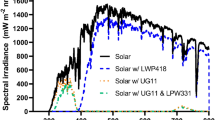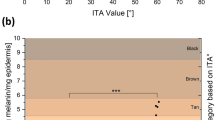Abstract
We report here that ultraviolet irradiation substantially reduced the mRNA and protein of the two major nuclear retinoid receptors, RAR-γ and RXR-α, in human skin in vivo. Pre-treatment with retinoic acid mitigated this loss of nuclear retinoid receptors. Ultraviolet irradiation caused a near-total loss of retinoic acid induction of two RAR/RXR target genes, cellular retinoic acid binding protein-II and RA 4-hydroxylase, but did not affect 1,25-dihydroxyvitamin D3 induction of the vitamin D receptor/RXR-regulated gene vitamin D 24-hydroxylase. In effect, ultraviolet irradiation causes a functional vitamin A deficiency that may have deleterious effects on skin function, contributing to skin photo-aging and carcinogenesis.
This is a preview of subscription content, access via your institution
Access options
Subscribe to this journal
Receive 12 print issues and online access
$209.00 per year
only $17.42 per issue
Buy this article
- Purchase on Springer Link
- Instant access to full article PDF
Prices may be subject to local taxes which are calculated during checkout




Similar content being viewed by others
References
De Luca, L.M. Retinoids and their receptors in differentiation, embryogenesis and neoplasia. FASEB J. 5, 2924–2933 (1991).
Futoryan, T. & Gilchrest, B.A. Retinoids and the skin. Nutr. Rev. 52, 299–310 ( 1994).
Pfahl, M. Nuclear receptor/AP-1 interaction. Endocr. Rev. 14, 651–658 (1993).
Mangelsdorf, D.J. & Evans, R.M. The RXR heterodimers and orphan receptors. Cell 83, 841– 850 (1995).
Chambon, P. A decade of molecular biology of retinoic acid receptors. FASEB J. 10, 940–954 ( 1996).
Imakado, S. et al. Targeting expression of a dominant-negative retinoic acid receptor mutant in the epidermis of transgenic mice results in loss of barrier function. Genes Dev. 9, 317– 329 (1995).
Saitou, M. et al. Inhibition of skin development by targeted expression of a dominant-negative retinoic acid receptor. Nature 374, 159–162 (1995).
Feng, X. et al. Suprabasal expression of a dominant-negative RXR alpha mutant in transgenic mouse epidermis impairs regulation of gene transcription and basal keratinocyte proliferation by RAR-selective retinoids. Genes Dev. 11, 59–71 ( 1997).
Kastner, P., Mark, M. & Chambon, P. Nonsteroid nuclear receptors: what are genetic studies telling us about their role in real life? Cell 83, 859–869 (1995).
Kumar, R., Shoemaker, A.R. & Verma, A.K. Retinoic acid nuclear receptors and tumor promotion: decreased expression of retinoic acid nuclear receptors by the tumor promoter 12-O-tetradecanoylphorbol-13-acetate. Carcinogenesis (London) 15, 701–705 (1994).
Darwiche, N. et al. Loss of retinoic acid receptors in mouse skin and skin tumors is associated with activation of the ras(Ha) oncogene and high risk for premalignant progression. Cancer Res. 56, 4942– 4949 (1996).
Lotan, R. et al. Suppression of retinoic acid receptor-beta in premalignant oral lesions and its up-regulation by isotretinoin. N. Engl. J. Med. 332, 1405–1410 ( 1995).
Darwiche, N. et al. Mouse skin tumor progression results in differential expression of retinoic acid and retinoid X receptors. Cancer Res. 55, 2774–2782 (1995).
Lotan, R. Retinoids in cancer chemoprevention. FASEB J. 10, 1031–1039 (1996).
De Luca, L.M. et al. Vitamin A in epithelial differentiation and skin carcinogenesis. Nutr. Rev. 52, 45–52 (1994).
Fitzgerald, P., Teng, M., Chandraratna, R.A.S., Heyman, R.A. & Allegretto, E.A. Retinoic acid receptor α expression correlates with retinoid-induced growth inhibition of human breast cancer cells regardless of estrogen receptor status. Cancer Res. 57, 2642–2650 ( 1997).
Marks, R. An overview of skin cancers: incidence and causation. Cancer 75, 607–612 (1995).
Shea, C.R. & Parrish, J.A. in Physiology, Biochemistry, and Molecular Biology of the Skin Vol. II (ed. Goldsmith, L.A.) 910 –927 (Oxford University Press, New York, 1991).
Campbell, C., Quinn, A.G., Angus, B., Farr, P.M. & Rees, J.L. Wavelength specific patterns of p53 induction in human skin following exposure to UV radiation. Cancer Res. 53, 2697–2699 (1993).
Fornace, A.J. Mammalian genes induced by radiation; activation of genes associated with growth control. Annu. Rev. Genet. 26, 507 –526 (1992).
Holick, M. Environmental factors that influence the cutaneous production of vitamin D. Am. J. Clin. Nutr. 61, 638S– 645S (1995).
Fisher, G.J. et al. Molecular basis of sun-induced premature skin ageing and retinoid antagonism. Nature 379, 335– 339 (1996).
Fisher, G.J. et al. Pathophysiology of premature skin aging induced by ultraviolet light. N. Engl. J. Med. 337, 1419– 1428 (1997).
Fisher, G.J. et al. Retinoic acid inhibits induction of c-Jun protein by ultraviolet radiation that occurs subsequent to activation of mitogen- activated protein kinase pathways in human skin in vivo. J. Clin. Invest. 101, 1432–1440 ( 1998).
Fisher, G.J. et al. Immunological identification and functional quantitation of retinoic acid and retinoid X receptor proteins in human skin. J. Biol. Chem. 269, 20629–20635 (1994).
Ohyama, Y. et al. Identification of a vitamin D-responsive element in the 5'-flanking region of the rat 25-hydroxyvitamin D3 24-hydroxylase gene. J. Biol. Chem. 269, 10545–10550 (1994).
Kang, S., Li, X.Y., Duell, E.A. & Voorhees, J.J. The retinoid X receptor agonist 9-cis retinoic acid and the 24-hydroxylase inhibitor ketoconazole increase activity of 1,25-dihydroxyvitamin D3 in human skin in vivo. J. Invest. Dermatol. 108, 513–518 (1997).
Li, X.Y., Xiao, J.H., Feng, X., Li, Q. & Voorhees, J.J. Retinoid X receptor-specific ligands synergistically upregulate 1,25-dihydroxyvitamin D3-dependent transcription in epidermal keratinocytes in vitro and in vivo. J. Invest. Dermtol. 108, 506–512 (1997).
Berlett, B.S. & Stadtman, E.R. Protein oxidation in aging, disease, and oxidative stress. J. Biol. Chem. 272, 20313–20316 (1997).
Grune, T., Reinheckel, T. & Davies, K.J.A. Degradation of oxidized proteins in mammalian cells. FASEB J. 11, 526–534 (1997).
Duell, E.A., Kang, S. & Voorhees, J.J. Retinoic acid isomers applied to human skin in vivo each induce a 4-hydroxylase that inactivates only trans retinoic acid. J. Invest. Dermatol. 106, 316– 320 (1996).
Arbour, N.C., Prahl, J.M. & DeLuca, H.F. Stabilization of the vitamin D receptor in rat osteosarcoma cells through the action of 1,25-dihydroxyvitamin D3. Mol. Endocrinol. 7, 1307–1312 (1993).
Xiao, J.H., Durand, B., Chambon, P. & Voorhees, J.J. Endogenous retinoic acid receptor (RAR)-retinoid X receptor (RXR) heterodimers are the major functional forms regulating retinoid-responsive elements in adult human keratinocytes. J. Biol. Chem. 270, 3001– 3011 (1995).
Fisher, G.J. & Voorhees, J.J. Molecular mechanisms of retinoid actions in skin. FASEB J. 10, 1002– 1013 (1996).
Nagpal, S., Athanikar, J. & Chandraratna, R.A. Separation of transactivation and AP1 antagonism functions of retinoic acid receptor-s alpha. J. Biol. Chem. 270 , 923–927 (1995).
van der Leun, J.C. UV radiation from sunlight: summary, conclusions and recommendations. J. Photochem. Photobiol. 35, 237–244 (1996).
Angel, P. et al. Phorbol ester-inductible genes contain a common cis element recognized by a TPA-modulated trans-acting factor. Cell 49, 729–739 (1987).
Fisher, G.J. & Voorhees, J.J. Molecular mechanisms of photoaging and its prevention by retinoic acid: Ultraviolet irradiation induces MAP kinase signal transduction cascades that induce AP-1-regulated matrix metalloproteinases that degrade human skin in vivo. J. Invest. Dermatol. Symp. Proc. 3, 61–68 ( 1998).
Saez, E. et al. c-fos is required for malignant progression of skin tumors. Cell 82, 721–732 (1995).
Astrom, A. et al. Molecular cloning of two human cellular retinoic acid-binding proteins (CRABP). Retinoic acid-induced expression of CRAPB-II but not CRABP-I in adult skin in vivo and in skin fibroblasts in vitro. J. Biol. Chem. 266, 17662–17666 (1991).
White, J.A. et al. cDNA cloning of human retinoic acid-metabolizing enzyme (hP450RAI) identifies a novel family of cytochromes P450 (CYP26). J. Biol. Chem. 272, 18538–18541 ( 1997).
Chen, K.S., Prahl, J.M. & DeLuca, H.F. Isolation and expression of human 1,25-dihydroxyvitamin D3 24-hydroxylase cDNA. Proc. Natl. Acad. Sci. USA 90, 4543–4547 (1993).
Fisher, G.J. et al. All-trans retinoic acid induces cellular retinol-binding protein in human skin in vivo. J. Invest. Dermatol. 105, 80–86 (1995).
Bradford, M. A rapid and sensitive method for the quantitation of microgram quantities of protein utilizing the principle of protein-dye binding. Anal. Biochem. 72, 248–254 ( 1976).
Acknowledgements
The authors thank C. Petersen and S. Rehbine for tissue procurement, J. Granger for technical assistance, L. VanGoor for graphics preparation, T. Hamilton for statistical analyses and A. Chapple for editorial assistance. We thank P. Chambon for RAR and RXR cDNA plasmids, M. Petkovich for human RA 4-hydroxylase cDNA, M. Haussler for human vitamin D 24-hydroxylase cDNA, and M.R. Uskokovic and P. Bollag at Hoffmann La Roche (Nutley, New Jersey) for 1,25-dihydroxyvitamin D 3 . This study was supported in part by the Babcock Endowment for Dermatological Research, the Dermatology Foundation (SK), and a grant from the Johnson & Johnson Corporation.
Author information
Authors and Affiliations
Corresponding author
Rights and permissions
About this article
Cite this article
Wang, Z., Boudjelal, M., Kang, S. et al. Ultraviolet irradiation of human skin causes functional vitamin A deficiency, preventable by all-trans retinoic acid pre-treatment. Nat Med 5, 418–422 (1999). https://doi.org/10.1038/7417
Received:
Accepted:
Issue Date:
DOI: https://doi.org/10.1038/7417
This article is cited by
-
Retinoic acid metabolism in cancer: potential feasibility of retinoic acid metabolism blocking therapy
Medical Molecular Morphology (2023)
-
Concomitant DNA methylation and transcriptome signatures define epidermal responses to acute solar UV radiation
Scientific Reports (2020)
-
Topical Retinoids: Therapeutic Mechanisms in the Treatment of Photodamaged Skin
American Journal of Clinical Dermatology (2016)
-
Enhanced expression of retinoic acid-metabolizing enzyme CYP26A1 in sunlight-damaged human skin
Medical Molecular Morphology (2011)
-
Oncogenic and cell survival properties of the retinoic acid metabolizing enzyme, CYP26A1
Oncogene (2010)



